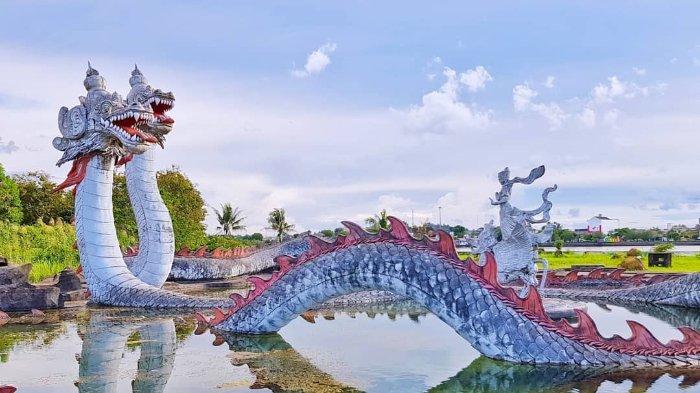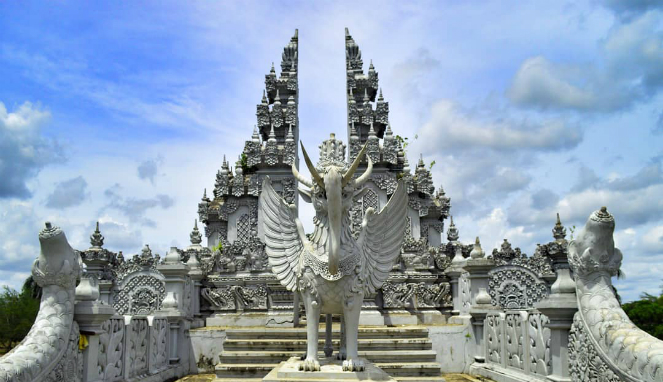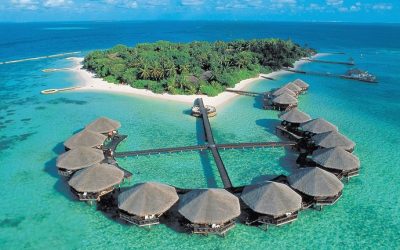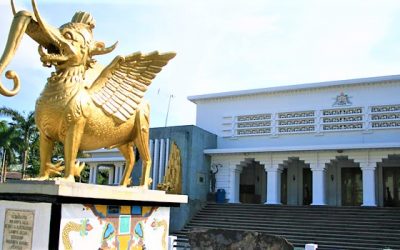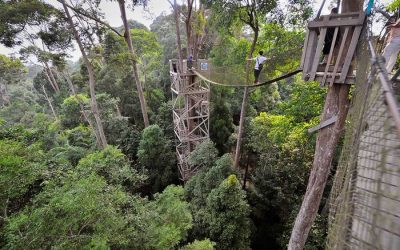Home / Batik Regions – Central Indonesia – Kalimantan Island – East Kalimantan / Kumala Island of Mahakam River
Cultural Destination
Embrace the spirit of the place!
Kumala Island of Mahakam River
The monument of Princess Karang Melenu and Erau Dragon (photo: @tribunswiki)
Hindu Shrine, Pura Pasak in Kumala Island (photo: Femina)
Kumala Island of Mahakam River
Do you want to fully experience the legacy of Kutai Kartanegara, the first kingdom in Kutai? Don’t miss Kumala Island. It is an 81-hectare delta that looks like a ship in the middle of the Mahakam River. Kumala Island is a new tourist park associated with many local myths, such as the Lembuswana of the Kutai Kingdom, the legend of Karang Melenu, the legend of the Princess and Erau Dragon. It also has the Pura Pasak Hindu shrine, which is known for its exquisite sculptures, as well as a traditional Dayak building that serves as a cultural centre. The island also has many modern entertainment facilities such as horse-drawn carriages, go-carts, and river tour boats. It is accessible through the bridge that connects it with Tenggarong City.
Tourist Attractions in East Kalimantan
Derawan Island – Marine Conservation Site
Derawan is one of the national marine conservation sites where marine wonderful animals such as shark whales,
Museum of Mulawarman
Do you want to explore Dayak culture across centuries? This museum offers
Bangkirai Hill Natural Conservation Site
If you have always dreamt to do a little adrenaline outdoor activities,
East Kalimantan
Batik Motifs
Kuntul Perak
Kuntul Perak refers to Egret Silver Bird. This bird is a Kalimantan endemic animal that becomes the
Hiu Taliyasan
Indonesia is also home to the world’s largest fish, the whale shark (Rhincodon typus). Hiu Taliyasan refers to
Tengkawang Ampiek
With its many advantages, the Dayaks use this leaf in ritual ceremonies. This plant is a symbol of
Discover
Indonesian
Batik
Motifs
Gamolan
This motif illustrates Gamolan, a bamboo musical instrument of Lampung that is
Daun Sirih
This motif illustrates betel leaves that are used by Lombok communities as traditional
Ikan tambal
The word “Ikan” refers to fish. The philosophical meaning of Ikan Tambal means is
Insang Ikan
Insang refers to the gills of the fish. This is a typical pattern of Malay ethnic who inhabits
Karawo Pinang
Pinang refers to the Palm areca tree. This motif is considered as the original
Gumin Tambun
Based on Hindu mythology, this motif symbolizes lucks, abundant wealth, and
Gedhog Kembang Waluh
a combination of Javanese cultural motif of the Majapahit kingdom (XII-XIV century) with
Parang Rusak
Another meaning behind this motif is an unconquerable spirit, symbolized by
Wakatobi
It symbolizes the coastal beauty of the Wakatobi island and the symbol of Patra symbolizes
Salakanagara
Salakanagara batik motif illustrates the first kingdom in the Betawi land
Tabir Tanjung
Tanjung flower is a type of Cherry tree flower, which is commonly found in
Tampuk Manggis Sasirangan
The motif illustrates the philosophy of the mangosteen fruit, which is
Keluak Daun Pakis
The word “Keluak” is a Minang language which means twisted or tangled. The Motif of
Wirasat
Wirasat or divine inspiration is a gift from God. This inspiration is symbolized by
Tubo Kelapa
Coconut tree is a symbol of a good character and strong mentality. It illustrates the more success a person, the more
Rangkiang
The word “Rangkiang” refers to the rice granary in the Minangkabau language. It symbolizes
Honai
The Honai is inspired by the traditional house of the Papuan community living in
Awan Berarak
Awan Berarak is a combination of Dayak motifs and Malay patterns. The word ‘Awan Berarak’ means the
Daun Simpor
This motif is inspired by the Simpor plant (Dillenia Suffruticosa) which is a typical
Kaharingan
The Kaharingan or ‘tree of life’ based on the Dayak tribes’ belief system. This tree symbolizes
Bekantan Pakis
This motif represents Pakis Haji (Polystichum setiferum), an endemic plant in
Dayak Taghol
Dayak Taghol has a distinctive style of four curved lines and small dots. This motif represents
Angsa Duo
According to legend, the Angso duo batik motif is a pair of swans that are believed to have led Princess
Bintik Tujuh
The Bintik Tujuh (Seven Dots) motif has 7 white spots and green color gradation as
Pinawetengan
The Pinawetengan Batik pattern was taken from a prehistoric inscription in
Tengkawang Ampiek
With its many advantages, the Dayaks use this leaf in ritual ceremonies. This plant is a symbol of
Bultiya
The word ‘Bultiya’ is an acronym of the three major tribes in North Kalimantan, namely
Sandeq
Sandeq Boat is a symbol of the maritime importance of the West Sulawesi region. The greatness of
Gurdo Solo
Gurdo or garuda bird is the mount of the Indian god Vishnu. As the Sun Bird,
Sido Mulyo
Sidomulyo is one of the classical motifs, which is specifically used for the bride’s costume in
Kasih Tak Sampai
‘Kasih Tak Sampai’ is an idiom in the Indonesian language which refers to
Besurek Rafflesia
The term “Basurek” refers to a textile that contains letters or inscriptions
Gigi Haruan Lidi
The Gigi Haruan Lidi motif is taken from the name of the cork fish and is a symbol of
Kaganga Tanah Rejang
If Batik Besurek combines Arabic calligraphy motifs, then the Kaganga batik takes
Tikar Natuna
The Tikar Natuna motif is adapted from the traditional making of pandanus mats in
Pucuk Rebung Riau
Pucuk Rebung symbolizes heart determination in achieving goals, good luck, and
Tongkonan
Toraja’s traditional house is called Tongkonan. Tongkonan is a place for
Malinau Cultural Festival
You will witness a unique competition that might not be found other than in
Tanah Liek
The word “Tanah Liek” refers to clay in Minang language. It is also known as
Gorga Simeol-Meol
The Gorga Simeol-meol is a pattern of plant tendrils. it is regarded as a symbol of longevity and
Hiu Taliyasan
Indonesia is also home to the world’s largest fish, the whale shark (Rhincodon typus). Hiu Taliyasan refers to
Desa Na Tolu
The Desa Na Tolu characteristic pattern symbolizes the Batak philosophy of existence and
Cengkeh
The clove flower motif is the main commodity of the Tolitoli Regency. This motif represents
Biji Kopi
The coffee seeds motif illustrates the pride of local coffee specialities in
Srimanganti
The name of the Srimanganti motif is derived from Palace’s hallway that connects to
Leuit Sijimat
This motif reflects the daily activities of the Baduy tribe in Banten. The main ornaments of batik motif consist of:
Jumputan Bintang
The word Jumputan means the tie-dye technique, while the word “Bintang” refers to
Sekomandi
Its philosophical meaning is the eternal union which refers to a saying “until death do us part”
La Galigo
La Galigo is a literary work of the Buginese Epic that has 300 thousand epic lines. It is considered even
Lok Baintan Floating Market
As you can imagine, the most authentic thing is that you can buy things and even
Parang Seling
Parang Seling or “alternating daggers” is a royal batik motif. It is a feminine variant of
Daun Lada Hitam
The black pepper motif represents the main commodity of Bangka Belitung
Tangerang Herang
Tangerang Herang motif is a symbol of Tangerang city. The Tangerang Herang batik motif consists of
Gonggong Beruntun
This motif illustrates that a person should maintain a positive attitude and
Rumah Mamuju
the Batik motif illustrates the house of Mamuju King with the stairs, located on the left of the wooden stage house
Bomba Mawar
This motif means sacred love for family, kingdom, and God; It also illustrates
Karawo Mahkuta
Mahkuta refers to Gorontalo’s traditional crown. It represents noble characters of
Sekar Jati
Sekar means flower and Jati refers to teak trees that symbolizes a strong mental character that
Ukir Sentani
The Ukir motif is a batik motif that is inspired by various traditional Sentani wood carvings
Ake Patra
Ake is related to the divinity and the composition of the universe. It is a symbol of
Pala Salawaku
This motif illustrates the unique weapons of the Maluku region, namely
Prada Papua
The word “Prada” in the Javanese-Indonesian dialect means a batik textile that
Enggang Dayak
Local people beliefs that hornbills are an incarnation of the Commander of the Birds. It has supernatural
Kuda Kupang
Horses symbolize wealth. It contains noble values of virtuous characters that bring
Paqbarre Allo
The word “Barre” means round and “Allo” means the sunlight. This motif is interpreted as
Pattimura
Pattimura is the name of an Indonesian hero who fought against colonialism in
Burung Bidadari
Bidadari birds are endemic birds in Halmahera. This motif represents an
Gentala Arasy
Built as high as 80 meters, the tower also highlights the historical side of
Tifa Totobuang
The batik motifs illustrate Maluku’s traditional music instrument called
Bale Lumbu
This motif signifies the welfare of the ancient Sasak society. Bale also symbolizes the
Raja Ampat
Raja Ampat motif represents the marine life at Raja Ampat archipelago in
Pati-Pati Pinehiku
It symbolizes the hierarchy in society and the social status of the Mekongga

